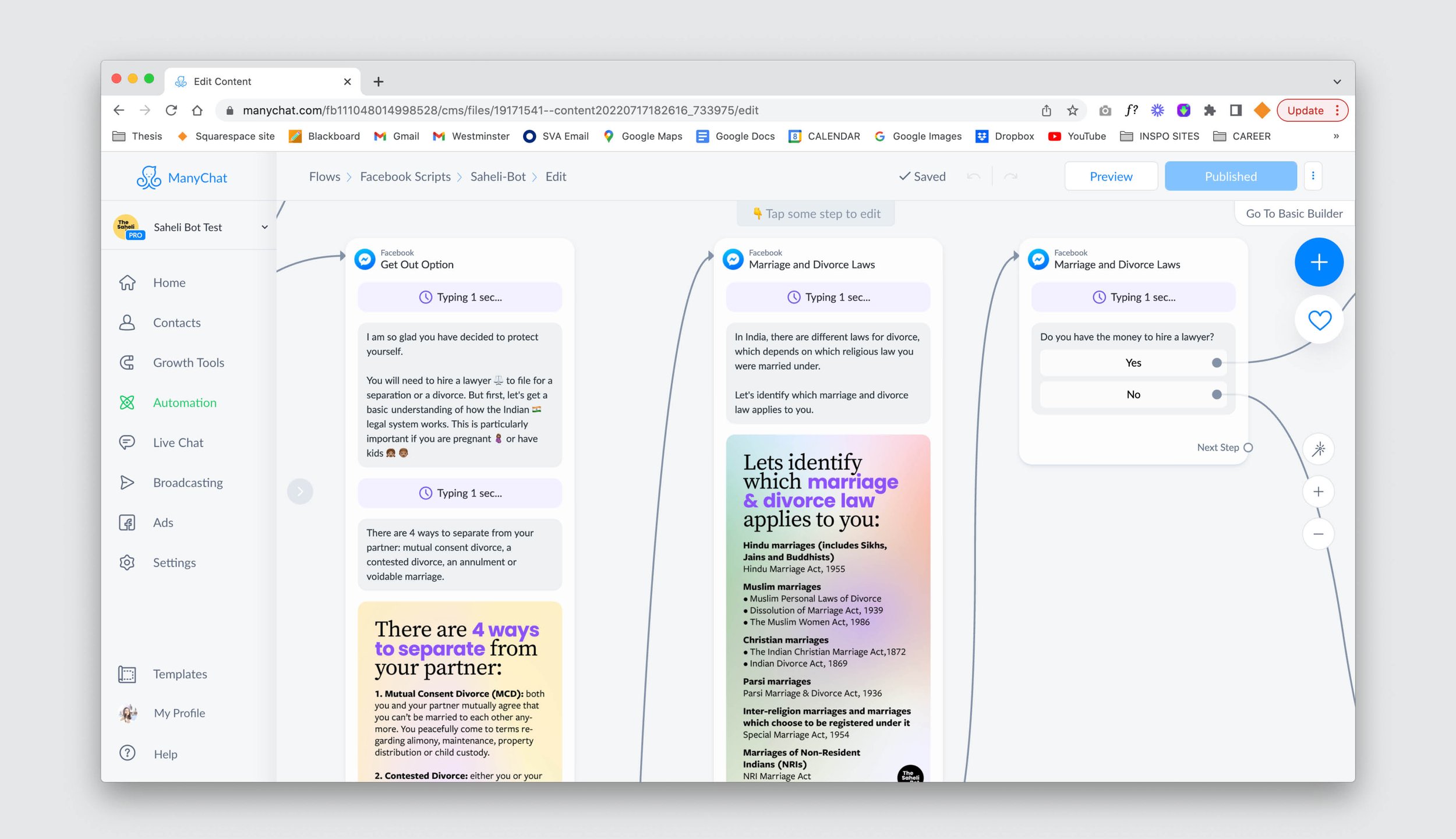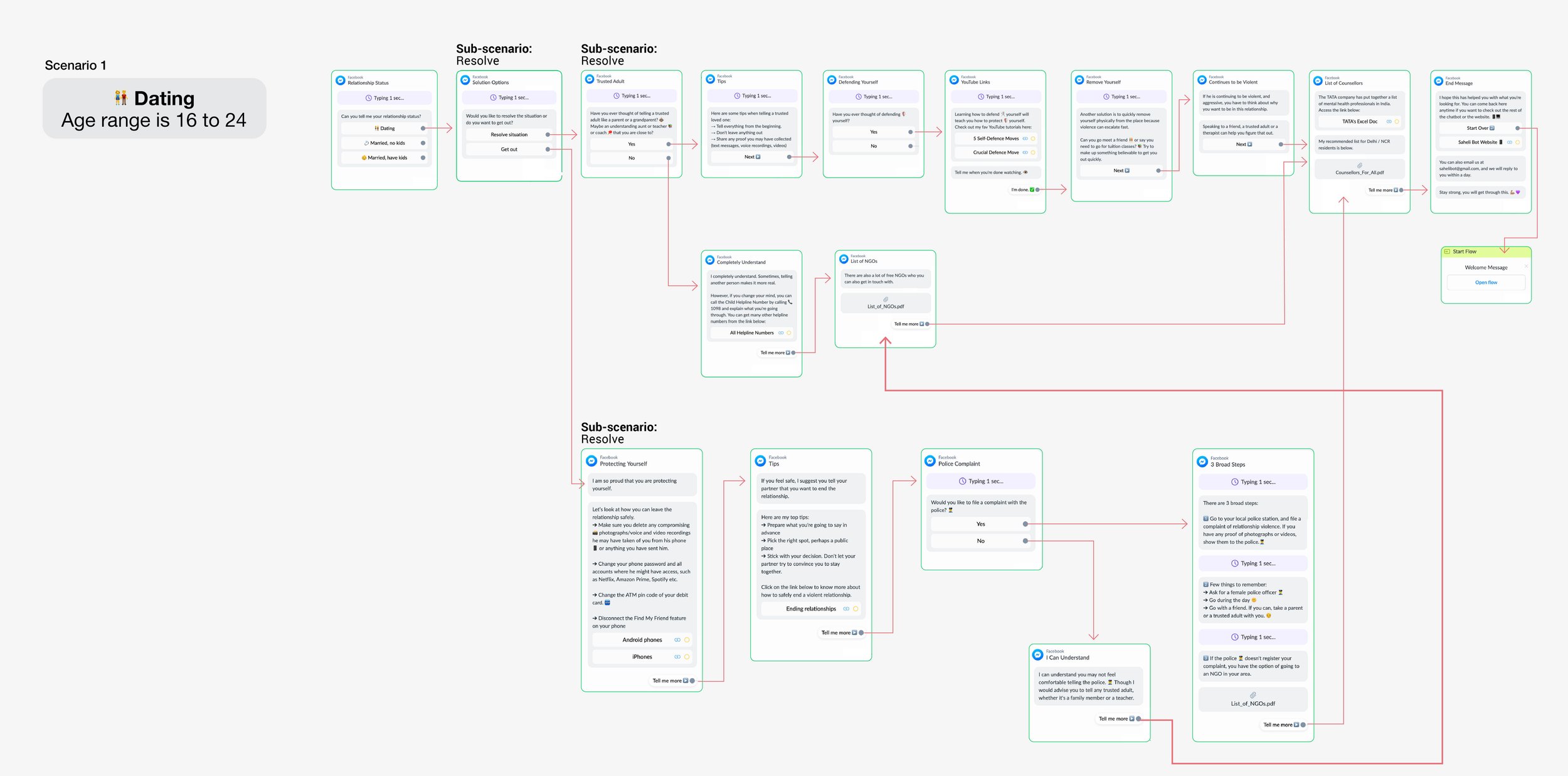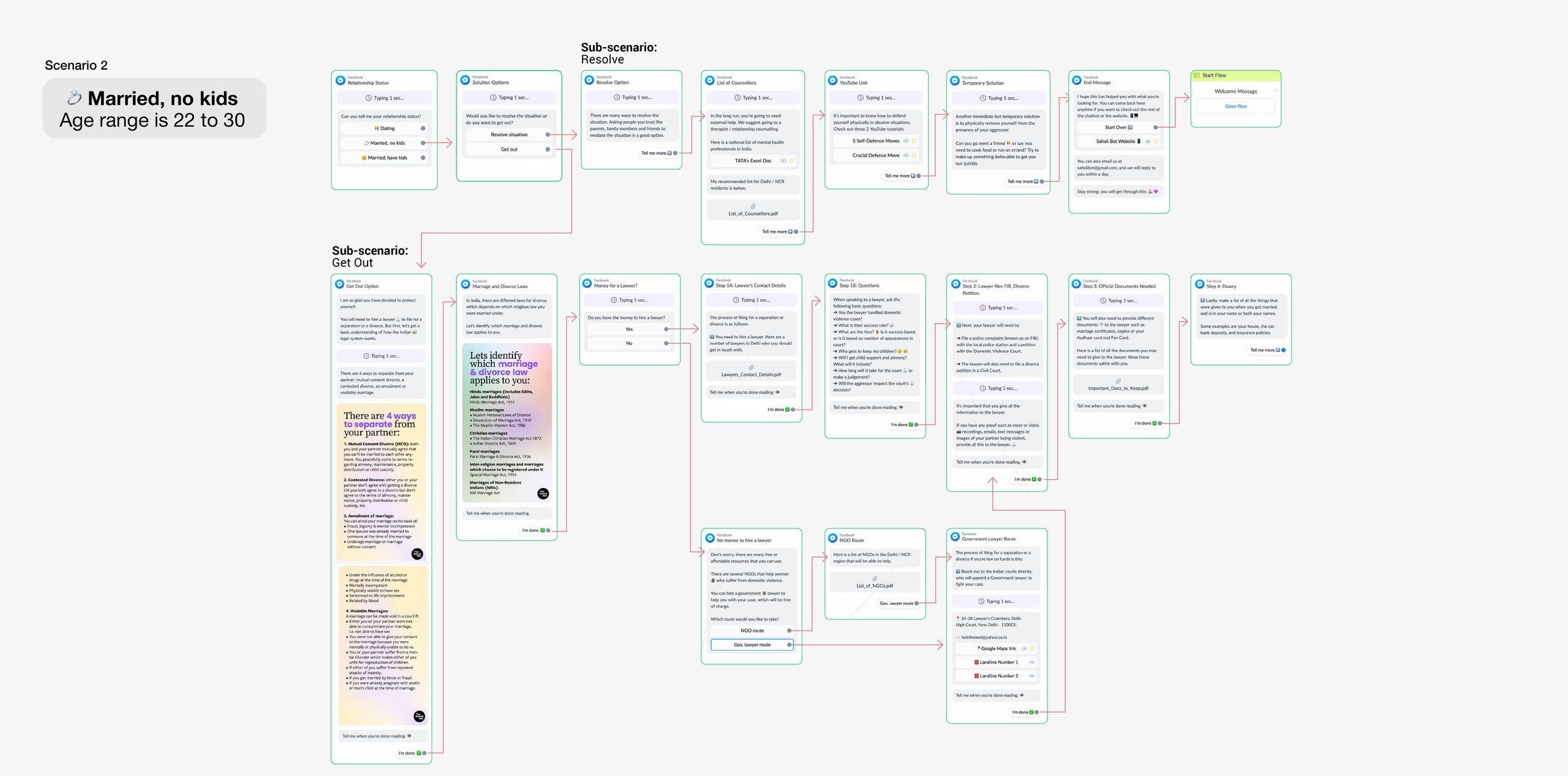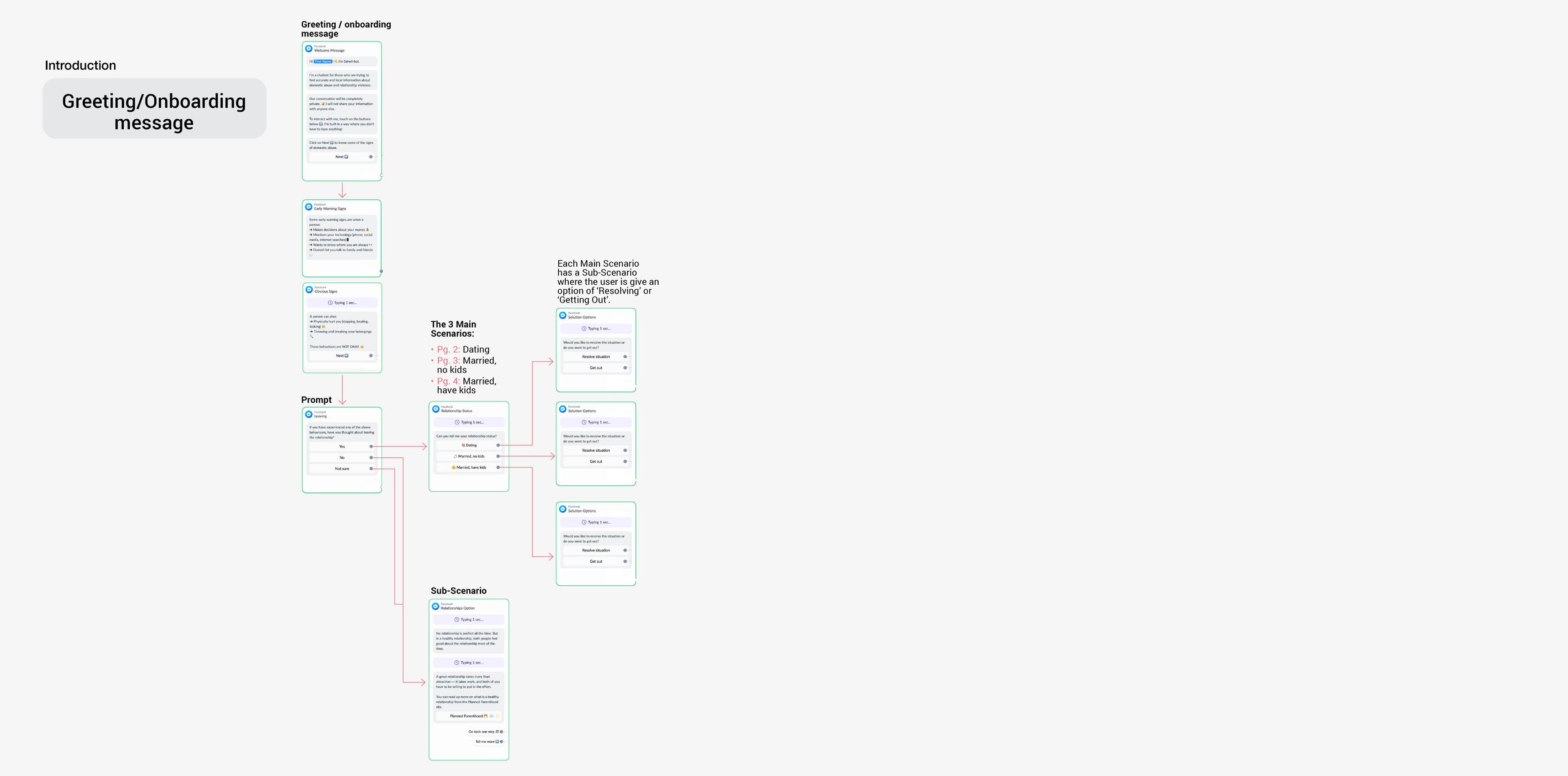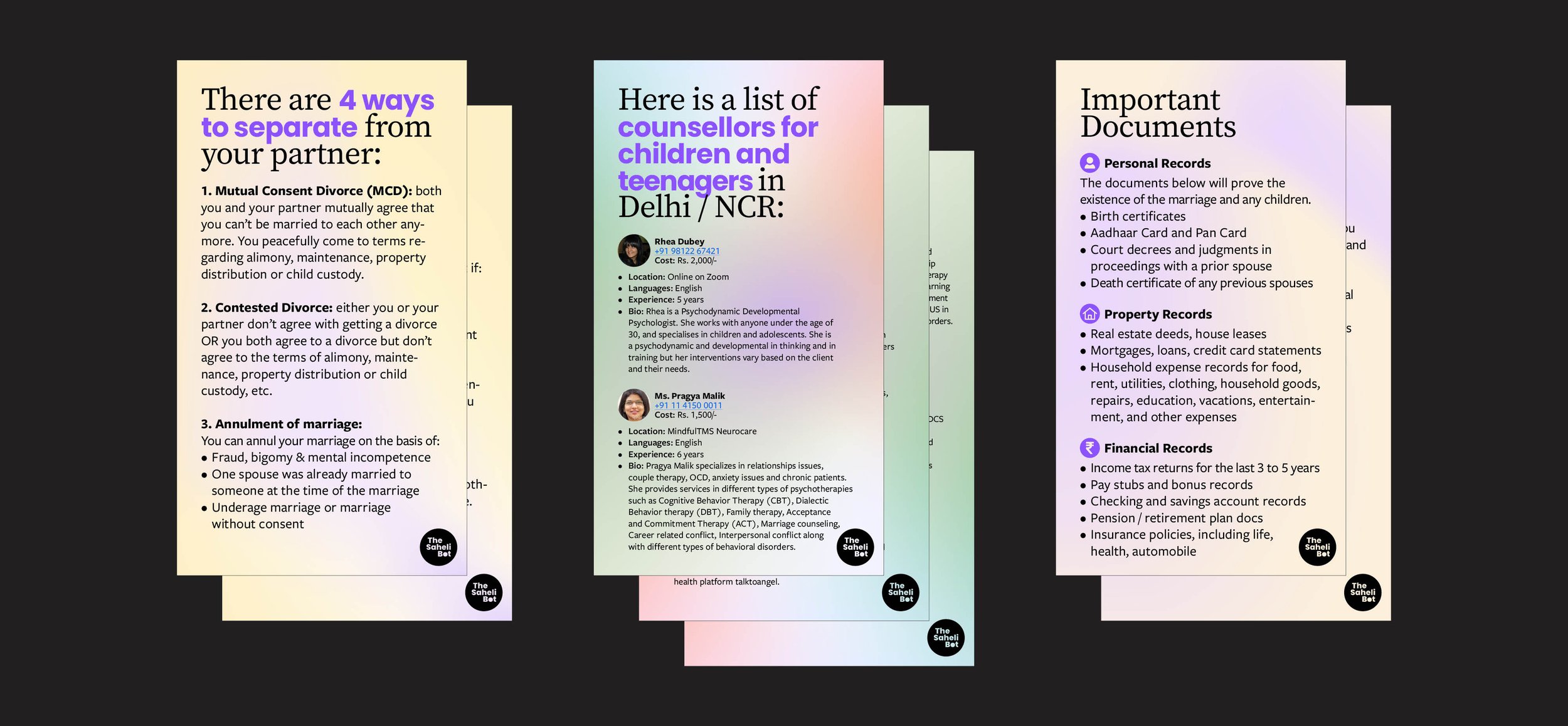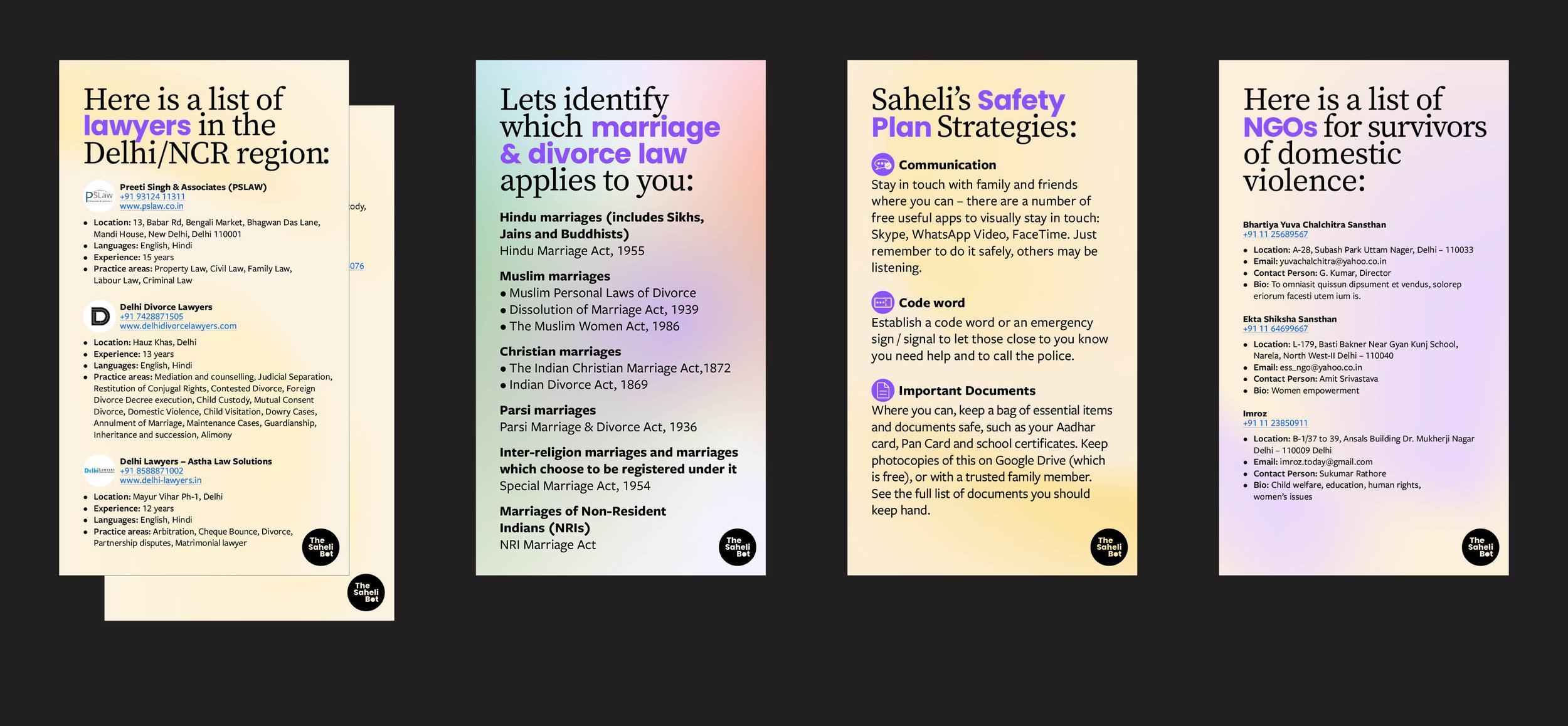Saheli Bot is a chatbot that gives accurate and local information about domestic abuse and relationship violence to women in India.
OVERVIEW
A user can interact with the chatbot on the following platforms:
● Facebook Messenger: @sahelibot
● Instagram: @sahelibot
● The website: www.sahelibot.com
Saheli Bot was the final project that was done during my time in the Interactive Media Practice program at the University of Westminster.
THE PROBLEM
While my major project has seen many different ideas, names and faces, my guiding question has always been, ‘How can I use technology to empower women?’ Currently, there are no digital tools that cater to the Indian population who might be dealing with sensitive topics such as domestic abuse and relationship violence.
METHODOLOGY
The Design Thinking framework was used to guide this project because of the cyclical nature that encourages constant iterations and testing, which was crucial for the success of the chatbot.
Time: 6 weeks
Role: UX Design, Conversation Design, Strategy, Prototyping, Development
Tools: ManyChat, Adobe Creative Suite (Illustrator, Indesign, Photoshop, After Effects, Premiere), Miro, Zoom
Collaborators: Rhea Dubey, Kairavi Chahal, Deepa Sinha, Zia Khanna
Mentors: Savraj Matharu, Francesc Moya Serra, Alvaro Infante, Michal Heichal
STAGE 1: UNDERSTAND – EMPATHIZING AND DEFINING
DESK RESEARCH: As a first step, it was critical to gather information and data that would help frame the problem and contextualise the landscape. In-depth desk research and discovery was conducted in the form of exploring other digital interventions such as websites, apps and chatbots. It was concluded that in the Indian context, although there are plenty of NGOs, chat forums, and helplines available, there are no digital interventions. Developed countries have a variety of resources such as mobile apps, AR/VR apps, chatbots, games and websites.
KEY FINDINGS
The Brith Sky app had some excellent features, but was available only in the UK
The Welsh chatbot ‘You Are Not Alone’ and the Australian chatbot ‘Women and Girls Emergency Centre’ was the most relevant.
The Woebot was excellent in terms of script.
INTERVIEWS: Extensive research was conducted to develop a deep understanding of the different stakeholders, i.e. victims of domestic abuse. Everyone had their own story to tell, with tips and tricks and little ways to deal that helped them. To respect the wishes of the victims, the conversations will not be shown in this case study except for Key Findings.
KEY FINDINGS
1. 95% of the women I spoke to said that there is little to no information available online about sensitive topics such as domestic abuse and relationship violence in the Indian context. The common thread among all was a lack of reliable resources in the Indian context.
2. In retrospect, they wished there was a way for them to find a digital tool in the middle of said trauma – Instagram accounts dedicated to domestic abuse and relationship violence was what they had been interacting with so far. They were now constantly seeking out digital tools for their overall mental health issues by downloading apps such as Headspace.
4. Three out of four women interviewed said that they were able to leave their partner only because they had their family’s financial backing to do so.
5. The biggest drawback of a digital tool was that nobody wanted to download an app while they were going through a long-standing traumatic event, as that was ‘too real’ for them, and ‘didn’t want to admit to the trauma in their lives to that extent’.
6. When similar websites were proposed as a solution, the feedback was that it was ‘just too much, and wanted something more digestible’. Which is how the idea of a chatbot was born.
DEMOGRAPHIC
Saheli Bot will focus on women between the ages of 16 to 35 years living in tier 1 and tier 2 cities in India, with the pilot phase focussing on women in the Delhi/NCR region. This age group sees the highest number of domestic abuse cases. Hopefully, their openness to using digital tools to solve such personal issues and talking about it will help them.
The pilot phase of this project focuses on women in the Delhi/NCR region with market size and potential of 6.77 million women. If we were to assume that only 10% were to use Saheli Bot, the number of women who may interact with this chatbot is 0.68 million. The diagram below illustrates how the figure of 0.68 million was reached
THE SOLUTION
After extensive research, it was concluded that building a chatbot would be the ideal solution to such a problem. Gender-Based Violence related events often have shame and social stigma attached to it, preventing victims from talking about it openly. Introducing a digital intervention in the form of a chatbot that guides them has been effective in other countries.
Chatbots can be configured to provide social and legal information, and are available around the clock and in situations of limited mobility.
Mobile apps are a barrier to entry as a majority of people don’t like downloading ‘yet another app’. The high costs are a major obstacle as they are expensive to build and maintain, especially if it includes VR technologies.
A victim of domestic violence is often scared that the perpetrator might find the app on her phone.
Chatbots can be quickly updated with changing laws and availability of resources and is accessible through a website or messaging platforms such as Facebook Messenger, Instagram and WhatsApp. During the research phase, it was found that
People in distress need this type of information to be presented in a digestible manner, unlike apps and websites that force the user to sift through the information themselves.
PROJECT GOALS
The goals of the chatbot was to provide accurate and local information to women who are victims of domestic abuse and relationship violence in India by
Facilitating dialogue and communication that the user has with herself, in the form of self-reflection and understanding of the information provided.
Providing context and feedback to a user regarding the status of their ‘request’
Delivering the experience via a familiar and understandable conversational experience via a messaging platform.
USER JOURNEY MAPPING
A user journey map was created based on the most complex user journey, which was the 3rd scenario: when a woman is married, and has kids. This scenario covers the journey of the 1st and 2nd scenario pretty closely.
STAGE 2: IDEATING AND PROTOTYPING
SHOULD IT BE A RULE-BASED, AN NLP OR A HYBRID CHATBOT?
At this stage, I came across an important question that would frame the approach and time of the project – what type of chatbot is feasible for a version 1, BETA release? It was concluded that a rule-based chatbot will be built because by pre-defining the structures and answers, users get a better experience. AI or NLP chatbots require developers to feed the AI with insightful information that the chatbot can utilise to respond to the user’s questions and requests. ↓
WHAT INFORMATION SHOULD THE CHATBOT PROVIDE?
Saheli Bot helps women understand the path of separation and/or divorce in India, navigating the Indian legal system and find trusted lawyers. She also suggests the type of questions to ask lawyers, and provides information on reliable and trusted NGOs, counsellors, and mental health professionals. The Bot also provides a Safety Plan. ↓
WHERE WILL THE CHATBOT BE HOUSED?
ManyChat, a platform that allows you to build chatbots for multiple messaging apps, was chosen based on the pre-defined criteria of what a successful chatbot for domestic abuse victims will need, which were images, URL links, videos, GIFs and location sharing. ↓
SCRIPTS
To begin with, 3 scenarios based on the personas were defined:
A woman who was trying to gain financial independence
A woman who was trying to find a therapist
A woman who wanted to report a domestic abuse incident to the police and file a restraining order
Keeping in mind the scope and limitations of the ManyChat software, the first draft of the script was written on a collection of post-its and digitalized in a word document. This process was based on the Wizard of Oz prototyping methodology, a way to test a prototype without actually developing it in the software. This script was created on a Google doc based on the first scenario of a woman trying to gain financial independence. It was a breakthrough discovery, as it not only taught me the script writing process, but a huge amount of quality insights were gained regarding how to write for Conversation Design in this subject in particular. ↓
STAGE 3: MATERIALIZE – TEST AND IMPLEMENT
REVISE AND TEST
Over the next few weeks, 3 scripts were written based on the test personas. It was concluded that the scripts were too similar because the scenarios were not distinct enough. The redefined scenarios were as follows:
Scenario 1: Dating 👫
Scenario 2: Married, no kids 💍
Scenario 3: Married, with kids 👶
As a result, all 3 scripts were revised and tested several times over, in a cyclical manner. Next, the scripts were transferred to a Decision tree format to understand the different possible paths. It was instantly realized that the amount of text would be too long for a chat interface, and would need to be cut down. At this point, a rough version of the resources was also designed in a 1080x1920 px format. The screenshot below shows the revised Decision Tree. ↓
TEST, FEEDBACK AND REPEAT
This chatbot was based on consulting and testing with 3 mental health professionals, 1 UX designer and 2 users throughout the project. Key feedback points have been divided into 3 categories in the table below: content, language used and user experience. The points listed below were IMPLEMENTED IN THE CHATBOT. ↓
Next, the final version of the first Decision Tree script was implemented into the ManyChat software. This stage saw the maximum number of revisions and tests on users. Once satisfied with the conversation, the process was repeated for the other 2 scripts.
The bulk of the time spent on this project was the script writing and testing with industry professionals and users, as it was realized very early on that to make a successful chatbot, the conversation can only be improved by constant feedback from users. Here are some of the screenshots of the script in progress in the ManyChat software. ↓
The final scripts can be seen below, based on the 3 different scenarios: of ‘👫 Dating’, ‘💍 Married, no kids’ and ‘👶 Married, with kids’ along with the Onboarding message and the Sub Scripts. ↓
You can download the PDFs here.
Saheli Bot also offers resources in PDF and jpg format that can be saved to the users device. These resources can also be shared via the chosen messaging platform (Facebook Messenger or Instagram) or any other external format such as WhatsApp, Emails, Telegram etc. ↓
The three videos illustrate one user journey of each of the 3 different scenarios.
CONVERSATION COMPONENTS
Words or phrases that make up a prompt, like acknowledgements, questions and chips (known as buttons or quick replies) are used to continue or pivot the conversation. Prompts and chips are the core of conversational interaction.
Display prompts have specific formatting requirements. ManyChat has a 2,000-character limit for messages and 7 character limit for chips. After a lot of trial and error, I found that a character limit of 100 to 300 was the ideal message size. I also found that the display prompts should be broken down to 1 or 2 parts. Emojis in the text display prompt also included "quotes" and most other unicode characters, including emojis. The different types of conversational components in Saheli Bot are broken down in the table below. ↓
AREAS THAT NEEDED IMPROVEMENT
Some of the messages ran a little long, they should have been broken in 2 parts
The ending was a bit abrupt. I put ‘Tell me more’ here for being consistent, but in retrospect, this is an area where I could have deviated from that consistency
It should have been ‘Married, with kids’ not ‘have’. Simple grammatical error.
WEBSITE
The Saheli Bot website was been built on WordPress because of its strong SEO features and lower costs to build. The website explains what the chatbot does, and dedicates a page to helpline numbers and other resources: www.sahelibot.com. ↓
MARKETING & SOCIAL MEDIA
A marketing strategy was built as well where Saheli Bot will be promoted through its own social media accounts as well as by giving talks about the project at conferences, university talks and podcasts. View the Instagram feed here.
The campaign concept for Instagram and Facebook encourages users to “Ask the Wrong Question”. Women have constantly been told to ‘behave themselves’ or ‘show modesty’, but men can do as they please. It’s time to stand up against these popular views.
Each post under the campaign is based on common questions that girls and women ask, or have always thought about. View a more detailed Marketing Report here. ↓
















